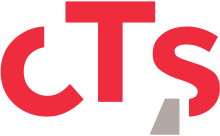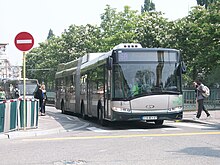Compagnie des Transports Strasbourgeois
These comprise 27 coach lines, of which 9 serve Strasbourg and participate in the Vélhop cycle network.
[3] At the end of the war, the network was heavily damaged and split in two: the outer-Rhine lines were transferred to the Republic of Baden in 1922.
The CTS turned towards tourism in 1932 with the creation of the ASTRA company, with luxury touring coaches.
Only the suburban network continued to run, to allow adequate provisioning of the French army.
[4] When Strasbourg became French again, the CTS faced a crisis, with a loss of human and material resources.
Buses would be easier for the armed forces to commandeer if war broke out again, and the company could not afford new locomotives for the network.
On 1 May 1960 the tramway made its last journey on the 12 km (7.5 mi) line 4/14 (Neuhof Forest Wacken), and finished dismantling the network, work which had progressed gradually since the end of the war.
An 030T Borsig T3[7] and a postal van, both classed as Monuments Historiques, are preserved by the CTS at their Kibitzenau depot.
Reconquering the market continued with the creation of 4 km (2.5 mi) of separate bus lanes, and the introduction of articulated buses.
The CTS refocused on public transport and resold ASTRA and its dedicated freight vehicles.
It was scheduled between 2006 and 2008, but several organisations and three individuals (including two elected Green councillors) appealed, and the work was delayed.
After a year of circulation, the company judged the tests inconclusive and announced that it would not be acquiring further hybrid vehicles.
[16] At the end of 2010, the city and the CTS filed a project to create a pneumatic tramway on the Wolfisheim – Vendenheim route via Strasbourg in the 2nd call for busway projects for Grenelle II[17] This plan was widely criticised by local associations, residents, and the municipality opposition.
[17] In parallel with the announcement of abandoning hybrid fuel, the company decided to continue buying vehicles running on natural gas.
Called the tarification solidaire, it recognises income splitting, but applies only to season tickets paid by subscription.
The lump sum contribution of local (direct subsidiary) collectives brought in €47,955,557, or 24.6%, and transfer charges €40,766,350, or 21.0% of income.
But in 2009, assets included the suburban network, which today is run by a sister company, the CTBR.
Strasbourg's tramway network, unlike those of some other towns and cities in France, is more of a grid (rather than being hub and spoke).
In the city centre, all tracks are shared by at least two lines, and three lines share the tracks between the stations of Homme de Fer and Observatoire, which makes for easy interchange and increases service frequency in the city centre.
The network is integrated into the tramway lines, and does not go into the most central part of the city, which is reserved for pedestrians and trams.
In 2008, the CTS established a joint venture with Transdev, Mugler and Striebig to operate Réseau 67 ("Network 67").
[30] Plans were that by the end of 2011, over 4,400 Vélhops could be hired from automatic stations, either inside shops or on specially-equipped buses.
[8] In the 1980s, the network consisted only of bus routes operated by a single model, the Renault SC10, and the livery was the same on every vehicle: cream on the top with red on the bottom.
As new bus models appeared, at the start of the 1990s, the company slightly changed the livery; the white background stayed, but several red-orange bands reappeared on the vehicles.
The 29 new natural gas-powered vehicles (14 articulated and 15 standard Irisbus Citelis units) delivered in 2011 were decorated by the artist Tomi Ungerer.
[32] They are all "mixed", and can handle both buses and trams (repair and maintenance shops and cleaning stations).
[44] A single track connects the Rotonde station with the depot, and so allows trams to access the rest of the network.
Two lorries called Aspirails travel the tramway network each day, to get rid of foreign objects in the rail grooves.
[49] If there is a fault on the rolling stock or the fixed infrastructure, the CTS has a fleet of road-rail vehicles, such as tractors, a Unimog and several bulldozers.
Maintenance equipment is not painted in the CTS livery: vehicles are white, with the company logo affixed.
















